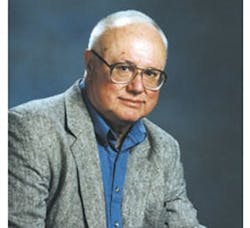Mike Bacidore is the editor in chief for Control Design magazine. He is an award-winning columnist, earning a Gold Regional Award and a Silver National Award from the American Society of Business Publication Editors. Email him at [email protected].
In May, I had the unique privilege of visiting with Dick Morley, largely considered to be the father of the PLC. Now in his 80s, Morley is a treasure chest of stories and insights. But his mind is much more than a collection of memories. Like the universe itself, it’s still expanding and revealing its mysteries to those who are fortunate enough to listen.
While he’d much rather discuss the intricacies of quantum entanglement, Morley slowed down long enough to explain how the programmable logic controller (PLC) came into existence. And, as Morley tells it, the development of the PLC followed a path that was as independent as it was inevitable.
“Allen-Bradley and General Motors were interested in something that solved the problem,” explained Morley. “But we didn’t follow the spec. The reason it works is because it’s so simple. I used relay logic. The programmable controller is a box of relays. I just built one—simplicity. We built them, and we didn’t know we were building them. Toyota credits me with making them a big company because the Japanese at that time couldn’t understand American software.”
Also read: The father of the PLC explains its birth
The original PLC, built by Morley and his colleagues at Bedford Associates, had only four outputs. “Mathematically, you only need three, but I put four in,” he said. “Then guys started making an infinite string, which is the wrong way to go. Albert Einstein says to make everything as simple as you can, but no simpler. The way to make a product is to take stuff out, not to put stuff in.”
Once the first PLC was given the green light, Morley wasn’t sure where the money was going to come from for production. He found it in General Motors’ maintenance allocation. “They had an infinite budget to fix the automation line, whatever the cost,” explained Morley. “So, we used the repair and maintenance budget to build them. We made them, and the thing took off like a bandit. We couldn’t keep up.”
The PLC is a fixed object, said Morley, and it tends to be open source. “Most engineers want a solution that’s the same size as the problem,” he explained. “The programmable controller is a solution for all problems.”
If you want to create software or a product that’s a “keeper,” like the telephone handset, you can’t just create one solution that fits the problem, said Morley. “The programmable controller is not just a solution; it’s several big solutions,” he explained.
Always looking to the next problem, Morley’s mind continues to expand. Not even Einstein’s special theory of relativity can explain how it can be in so many places at once. But the manufacturing industry is still thankful that Morley’s mind was in Bedford, Massachusetts, in 1968 when a few relays were put in a box and the PLC was born.






